Our selection of premium-quality extra virgin olive oil from Spain. Oils from Spanish cooperatives and oil mills compromised with quality and sustainability!
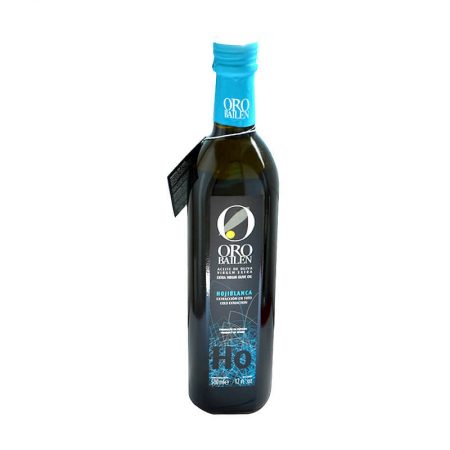 Hojiblanca Olive Oil of Oro de Bailen 500 ml12.50 €Extra virgin olive oil of the variety hojiblanca of Oro Bailen Characteristics Extra virgin olive oil bottled in a dark glass bottle of design and coating the stopper blue. Aroma Oro Bailen Reserva Familiar’s extra virgin olive oil of the variety hojiblanca has a brilliant green color, luminous like the rest of its oils. In […]
Hojiblanca Olive Oil of Oro de Bailen 500 ml12.50 €Extra virgin olive oil of the variety hojiblanca of Oro Bailen Characteristics Extra virgin olive oil bottled in a dark glass bottle of design and coating the stopper blue. Aroma Oro Bailen Reserva Familiar’s extra virgin olive oil of the variety hojiblanca has a brilliant green color, luminous like the rest of its oils. In […]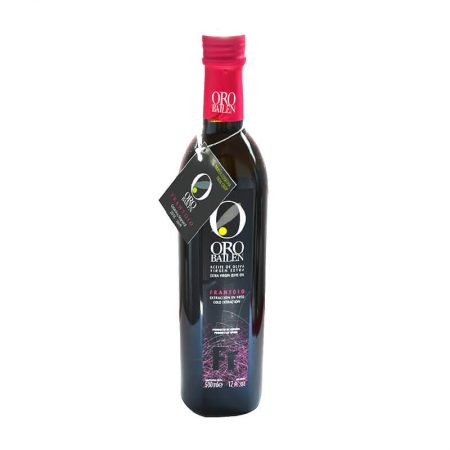 Olive oil Oro de Bailen Frantoio 500 ml12.50 €Extra virgin olive oil of the frantoio variety of Oro Bailen Characteristics Extra virgin olive oil bottled in a dark glass design bottle Aroma Oro Bailen Reserva Familiar’s extra virgin olive oil of the frantoio variety has a bright, luminous green colour. In the mouth you can appreciate an intense fruity fresh olive, with enormous […]
Olive oil Oro de Bailen Frantoio 500 ml12.50 €Extra virgin olive oil of the frantoio variety of Oro Bailen Characteristics Extra virgin olive oil bottled in a dark glass design bottle Aroma Oro Bailen Reserva Familiar’s extra virgin olive oil of the frantoio variety has a bright, luminous green colour. In the mouth you can appreciate an intense fruity fresh olive, with enormous […]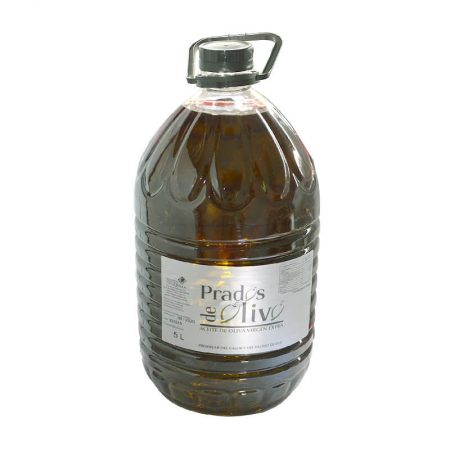 Olive oil Prados de Olivo 5 l54.50 €Extra virgin olive oil 5 L of Prados de Olivo. Natural blend mainly of the Picudo and Hojiblanca varieties. 1. Characteristics of the oil of Prados de Olivo 5 l Extra virgin olive oil bottled in a transparent plastic bottle (PET) a) Aroma The extra virgin olive oil of the Prados de Olivo is a […]
Olive oil Prados de Olivo 5 l54.50 €Extra virgin olive oil 5 L of Prados de Olivo. Natural blend mainly of the Picudo and Hojiblanca varieties. 1. Characteristics of the oil of Prados de Olivo 5 l Extra virgin olive oil bottled in a transparent plastic bottle (PET) a) Aroma The extra virgin olive oil of the Prados de Olivo is a […]
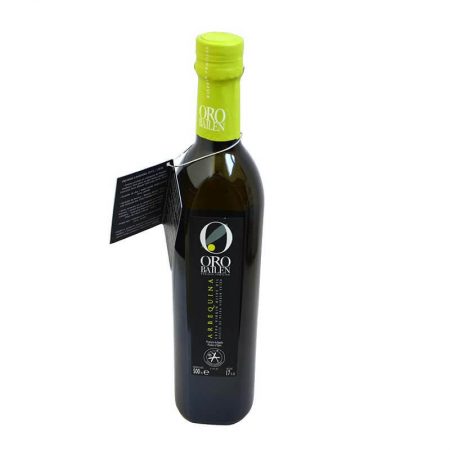 Arbequina olive oil Oro Bailen 500 ml13.90 €Extra virgin olive oil of the Arbequina variety 1. Characteristics of the arbequina oil of Oro Bailen: Extra virgin olive oil bottled in a dark designer glass bottle a) Aroma Oro Bailen Reserva Familiar extra virgin olive oil of the Arbequina variety has a bright green, luminous colour. On the palate it is possible to […]
Arbequina olive oil Oro Bailen 500 ml13.90 €Extra virgin olive oil of the Arbequina variety 1. Characteristics of the arbequina oil of Oro Bailen: Extra virgin olive oil bottled in a dark designer glass bottle a) Aroma Oro Bailen Reserva Familiar extra virgin olive oil of the Arbequina variety has a bright green, luminous colour. On the palate it is possible to […]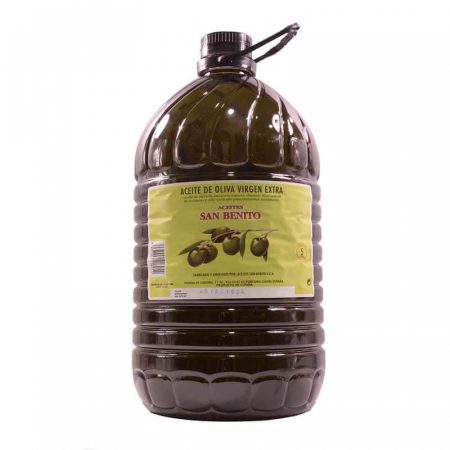 Picual Olive Oil San Benito 5 l52.90 €Extra virgin olive oil of the picual variety 1. Characteristics of olive oil of San Benito: Extra virgin olive oil bottled in a plastic bottle (PET) a) Aroma San Benito’s extra virgin olive oil of the picual variety is a strong, balanced oil, with a great taste, a little itching and bitterness. In the mouth […]
Picual Olive Oil San Benito 5 l52.90 €Extra virgin olive oil of the picual variety 1. Characteristics of olive oil of San Benito: Extra virgin olive oil bottled in a plastic bottle (PET) a) Aroma San Benito’s extra virgin olive oil of the picual variety is a strong, balanced oil, with a great taste, a little itching and bitterness. In the mouth […]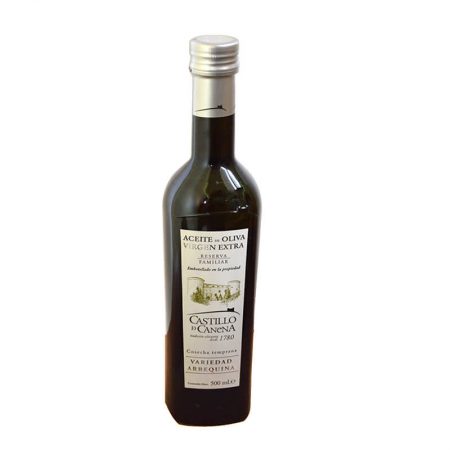 Arbequina olive oil Castillo de Canena 500 ml17.90 €Extra virgin olive oil of the Arbequina variety Family Reserve 1. Characteristics of the arbequina oil from Castillo de Canena: Extra virgin olive oil bottled in a dark designer glass bottle Cold extraction a) Aroma The extra virgin olive oil from Castillo de Canena Family Reserve of the Arbequina variety has a bright green, luminous […]
Arbequina olive oil Castillo de Canena 500 ml17.90 €Extra virgin olive oil of the Arbequina variety Family Reserve 1. Characteristics of the arbequina oil from Castillo de Canena: Extra virgin olive oil bottled in a dark designer glass bottle Cold extraction a) Aroma The extra virgin olive oil from Castillo de Canena Family Reserve of the Arbequina variety has a bright green, luminous […]
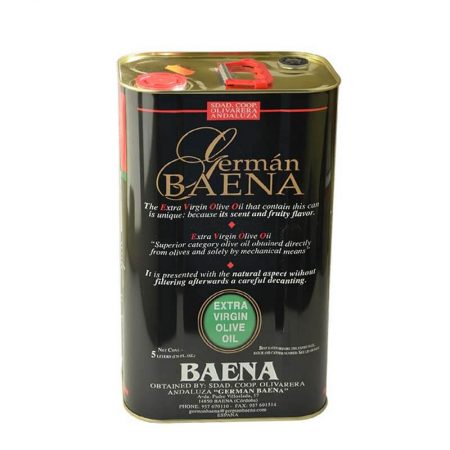 Olive oil Germán Baena 5 l59.50 €Unfiltered extra virgin olive oil. Natural coupage mainly of the varieties picual, picudo and hojiblanca 1. Characteristics of German Baena oil: Extra virgin olive oil bottled in a tin can a) Excellent quality German Baena’s extra virgin olive oil is a soft, balanced oil, with a great taste and very little spiciness and bitterness. In […]
Olive oil Germán Baena 5 l59.50 €Unfiltered extra virgin olive oil. Natural coupage mainly of the varieties picual, picudo and hojiblanca 1. Characteristics of German Baena oil: Extra virgin olive oil bottled in a tin can a) Excellent quality German Baena’s extra virgin olive oil is a soft, balanced oil, with a great taste and very little spiciness and bitterness. In […]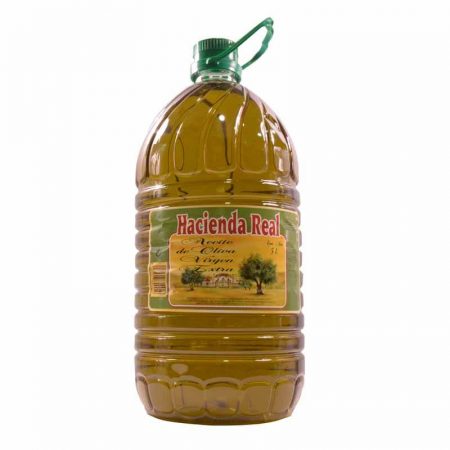 Olive oil Hacienda Real 5 l57.50 €Extra virgin olive oil filtered Hacienda Real 5 l. Natural coupage mainly of the varieties picual, picudo and hojiblanca 1. Characteristics of Hacienda Real oil: Extra virgin olive oil bottled in a PET plastic bottle a) Aroma Hacienda Real’s extra virgin olive oil is a smooth, balanced oil, with a great taste and very little […]
Olive oil Hacienda Real 5 l57.50 €Extra virgin olive oil filtered Hacienda Real 5 l. Natural coupage mainly of the varieties picual, picudo and hojiblanca 1. Characteristics of Hacienda Real oil: Extra virgin olive oil bottled in a PET plastic bottle a) Aroma Hacienda Real’s extra virgin olive oil is a smooth, balanced oil, with a great taste and very little […]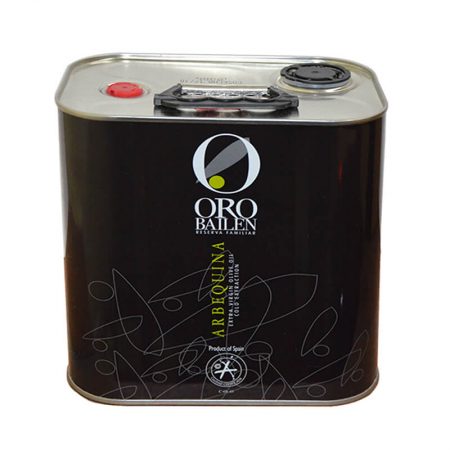 Arbequina olive oil Oro de Bailen 2.5 l47.50 €Extra virgin olive oil of the Arbequina variety of Oro Bailen 1. Characteristics of arbequina olive oil of Oro Bailen in tin 2.5 l: Extra virgin olive oil bottled in a can a) Aroma Oro Bailen Reserva Familiar extra virgin olive oil of the Arbequina variety has a bright green, luminous colour. On the palate it […]
Arbequina olive oil Oro de Bailen 2.5 l47.50 €Extra virgin olive oil of the Arbequina variety of Oro Bailen 1. Characteristics of arbequina olive oil of Oro Bailen in tin 2.5 l: Extra virgin olive oil bottled in a can a) Aroma Oro Bailen Reserva Familiar extra virgin olive oil of the Arbequina variety has a bright green, luminous colour. On the palate it […]
Our fantastic selection of extra virgin olive oils from Spanish olive mills and cooperatives.
Index:
|
Summary: Extra virgin olive oil, oil made only by mechanical extraction and not added additive. Consequently, it preserves all its nutrients and natural flavor. Furthermore, we offer the finest extra virgin olive oil from Spain in our shop of Las Rozas de Madrid. Also, all our producer only use sustainable and respectful agricultural practices.
Related articles: Our promotions, you don´t lose them-Curiosities of olive tree and its olive oil. Green oil, olive tree purity. Important characterístics of olive oil. The best denominations of Origin of olive oil.
1. Our selection of EVOOs
Firstly, here are the important characteristics of our premium-quality extra virgin olive oil.
a) Spain, the world’s leading olive oil producer
Spain is the world’s leading olive oil producer. Consequently, we are the first producer of the world and we have the most awarded extra virgin olive oils. One of the the first reason, is our knowlege, our land, varieties and tradicional techniques, that give us exceptional oils of extraordinary quality.
b) Maximum quality
We offer the finest selection of extra virgin olive oils from Spain. Furthermore, we have visited the olive field and oil mills to make sure that farmers use sustainable practices. Also, many of these olive oils are recognized nationally and internationally for its high-quality.
c) Excellence in production
In addition, our producers use the most advanced and best techniques of olive oil productions. Furthermore, our farmers harvest their olive at the optimal ripening moment, in order to produce only high-quality extra virgin olive oil.
d) State certifications
Additionally, our selections of olive oils has passed strict controls. In the case of organic and award winning oils, their control has been much more rigorous.
e) Sustainable production
Finally, we work with mills and cooperatives that use only sustainable and respectful practices of production. Also, we support to the rural economy.
“Exceptional oils of extraordinary quality from Spain”
1. What is extra virgin olive oil?
Secondly, olive oil is a vegetable fat that is only produced by a simple pressing of the olives. Its extraction is done by mechanical processes and no chemical is used to extract the oil. Therefore, extra virgin olive oil is a real olive juice in its most natural expression. Consequently, it retains extraordinary organoleptic properties.
a) Elaboration process
The elaboration process of olive oil, is a physical process of a simple pressing the olives and later separating the water and the oil by natural decantion or vertical centrifugation. This process of milling is also carried out at low temperatures, less than 30ºC in order to mantain all its natural properties and flavor. Unlike seed oils, which are obtained with a chemical process and at high temperatures.
Finally, the variety of olive, the microclimate, the soil and the time of milling produce different flabour in the EVOO (extra virgin olive oil). From this varietis, the culture of olive oil rises up.
In addition, here is a video of how extra virgin olive oil is extracted
Video 1: Exra virgin olive oil production
b) Types of olive oil
After milling, the obtained paste is centrifuged to saparate the water, rest of the olives and olive oil. Depending on the quality of the olive and how well it has been produced, we have different qualities of olive oil, which are described below.
- Extra virgin olive oil
- Virgin olive oil
- Lampante olive oil
- Olive-pomace oil.
Now we are going to see the different types of olive oil in greater detail.
1) The extra virgin olive oil
This is the olive oil that keeps all its organoleptic characteristics and passes the most rigorous quality tests. Among the chemical test it must have: a maximum of 0.8% acidity and an organoleptic score must be greater than 6, on a scale from 0 to 10.
Therefore, extra virgin olive oil is the highest quality olive oil. As a result, it is the one that brings us the greatest health benefits and the one that we should use for everything.
2) Virgin olive oil:
Virgin olive oil is an olive oil with slightly lower in quality, some organoleptic defects and higher acidity. It also cannot exceed 2% of acidity. This olive oil great health properties and is good for frying.
Also, when a extra virgin olive oil get old, it is longer classified as extra virgin and become a virgin olive oil.
3) Lampante olive oil:
Lampante olive oil is also obtained fron olives using mechanical process, but the olive are in bad condition or the process was made with careless. Consequently, this oil is not fit for human consumption.
Usually, this oil is refined and after the refining process it become a olive oil.
4) Refined olive oil:
Oil labeled “pure olive oil” or only “olive oil”. These oils comoe from olive oils that have been refined to weep out differents defects like high acidity. The refining process does not alter its glyceric structure. Finally, this refined oils are blended with a little of extra virgin olive oil or with a virgin olive oil.
We do not recommend these oils, because they have low health properties. Also, they have slightly aroma.
5) Olive-pomace oil:
Oil obtained from olive pulp after the first press using solvents and other physical treatments. Later, this oil is refined and we have olive pomace oil.
The pomace, which is the rest of the milling, olive stone and skin still contains around 5% of virgin olive oil. The pomace can no longer be extracted by physical means; it must be extracted by chemical means and at high temperatures. This oil, which is obtained by chemical methods, using mainly hexane, is called crude pomace oil.
Crude pomace oil has major defects and it is not for human consumption. Therefore, it must undergo more physical and chemical processes more or less extensive depending on its state, calling this process refining. Once the pomace oil has undergone the refining process, a little virgin or extra virgin olive oil is added. After that, we have ready the olive-pomace oil.
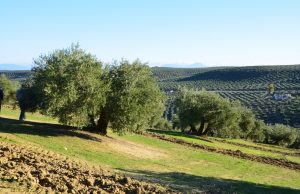
Phto 1: Fields of Jaén, in Andalucía, Spain.
2. Types of packaging
Simultaneously, these different formats are available for sell in the market and in our store.
| Packaging | Plastic | Can | Glass | Bag in box |
| Capacity |
|
|
|
|
| Characterístics |
|
|
|
|
| Benefits |
|
|
|
|
| Recommemdations |
|
|
|
|
Table 1: Different types of packaging.
a) More information
More information about the diferents packaging for olive oil.
Bag in box
It’s a new package for extra virgin olive oil that a few producers use. It is a very good packing because it preserves very well the properties and flavor of olive oil.
This packaging was created in Austria firstly. Llater producers from United States have started to use it and finally spanish producers are using them. In Spain it has been used firstly by wine producers, then other sectors such as beer, juices and vermouth. Now, a few extra virgin olive oil producer use this packaging.
The bag in box consists of a cardboard box with a special plastic bag inside. This bag is where the olive oil is stored. When the olive oil is inside, this bag closes hermetically and nitrogen could be added to take out all its oxygen.
When the consumer opens the bag in box and takes out the oil little by little, the bag is folded and compressed. As a consequence, at no time does oxygen enter in the inside. For this reason, this packaging is so good and it protects the olive oil from oxygen and light perfectly.
The high temperature can damage the olive oil. Consequently, you should always store your olive oil in a cool place.
Others
There are also other containers such as glass or ceramic. These are very rare, but sometimes you can find them on the market.
3. What olive oil should I buy?
Now you know that there are many types of olive oils, like: extra virgin olive oil, olive oil, pomance oliveoil. Furthermore, in the market you can find other classifications, such as organic, conventional, premium, first harvest, with or without Denomination of Origin, mild, strong olive oil. Hence, a whole mess, especially for somebody who does not know anything about olive oil.
Also, you can buy your olive oil in so many places, like cooperatives, mills, supermarkets, spezialized stores, etc. In order to answer this question, let’s read more about it.
a) In an oil mill or a cooperative?
Where should I purchase my olive oil, in a olive mill or a cooperative?. Also, who gives the best oil to the best price? and what do you find in each store?
First of all, one must know the difference between a cooperative and an oil mill.
-
A cooperative
A cooperative is an association of producers. The cooperative can be formed by a few members or by thousands. Each member has a vote in the company, which is independent of the quantity of her or his olives groves number. Therefore, in the decisions of the cooperative, each member has only one vote, and all votes are equally valid.
I am commenting on this, so that you can understand how they make decisions. Therefore, in a cooperative, as it is formed by many farmers, they usually focus only on oil production and do not want to get involved in commercial campaigns. As a consequence, they tend to offer high quality olive oils at a good price. Examples of this would be our cooperative in San Benito and the cooperative in German Baena.
-
The oil mill:
The oil mill consists of a single owner or a few partners. The company’s decisions are therefore made by a few people without the opinion of the rest. This allows the company to be taken to more competitive and commercial grounds. This is why we usually find the most awarded oils here. An example of this would be the oil mills of Oro del Desierto, Castillo de Canena, Oro Bailen.
-
Bottling plant
There is also the possibility of buying it from a packaging machine. In this case, it is a company that buys the oil and it carries out the bottling process. In these cases, one must be well informed about where the oil is obtained.
4. Formats
In our shop we have a wide range of formats. Formats for every taste and need. Among them, we have the following:
-
5 l format:
The 5 l format is the largest format allowed by Spanish law. For this format, we have plastic containers, tins and bag in boxes.
-
1, 2 and 3 l format
For these formats, we also have the three types of packaging, and sometimes, we have in the format of 1 l in glass. These formats are not as large as the 5-litre format, and allow for better handling, while at the same time the oil is more economical.
-
Formats smaller than 1 l:
We have all formats here as well. These formats are very suitable for premium oils, as they do not lose any of their properties during the time the bottle is open.
“For a healthy tomorrow”
6. FAQ
Let’s see frequent asked questions:
-
What is the harvest year?
We control as much as possible our store in order to offer only olive oil from the last harvest. However, you can ask us before you buy here your extra virgin olive oil.
-
What’s the expiration date?
All our oils that have only a few months left to their preferential consumption are withdrawn from sale.
-
it has a special color, is it freezed?
When olive oil take low temperatures, it freezes and it is normal. When the temperature gets normal again, the oil returns to its normal state.
-
How acidic are the oils?
The acidity level of all oils we offer is low about 1 %. If it is on the label, we indicate it on the description of each oil.
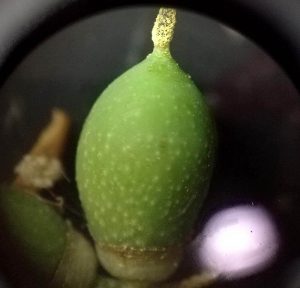
Photo 2: Olive in formation in June seen with a magnifying glass
-
Is it worth paying more than 20 euros for a bottle of olive oil?
When you get used to a good oil, you don’t about the price. If we look at the calories an oil provides and its benefits, quality olive oil is one of the cheapest foods.
-
Is OK to used expired olive oil?
It depends on the variety and how it was stored. However, you should smell it, if it smell fresh and good, it is ok. If it smell rancid, it has gone off.
In summary, we recommend not to consume olive oil with more than two years. If the olive oil has small stability like arbequina, you should consume in one year. Olive oils with bigger stability, you should not keep for more than three years.
-
Which oils have yellow or green colour?
The green color is given by the chlorophyll and the yellow by other minor components of the EVOO. Chlorophyll is more abundant when the olive is harvested early but chlorophyll disappears over time. For this reason, the oils have the greenest colour when are harvested early and their greenness becomes more yellow slowly. Likewise, the oils that are milled later are more yellow.
-
Do you have unfiltered olive oils?
Yes, we have. You can find them in our selection of Baena or Germán Baena. However, the rest are filtered.
Sources:
The english newspaper BBC
“Finally, if you would like more information. Please do not hesitate to contact us. We are happy to help you”.
Our schedule:
Monday to Friday:
10:00 a 14:00 y de 17:00 a 20:30
Saturday:
10:00 a 14:30
Contact us for more information
Mail: info@cortijuelosanbenito.es
Telephone: 91 603 14 63
Where are we at?
We’re in Spain, Madrid.
Avd Atenas 75, Local 103 Las Rozas
(28232) Madrid



